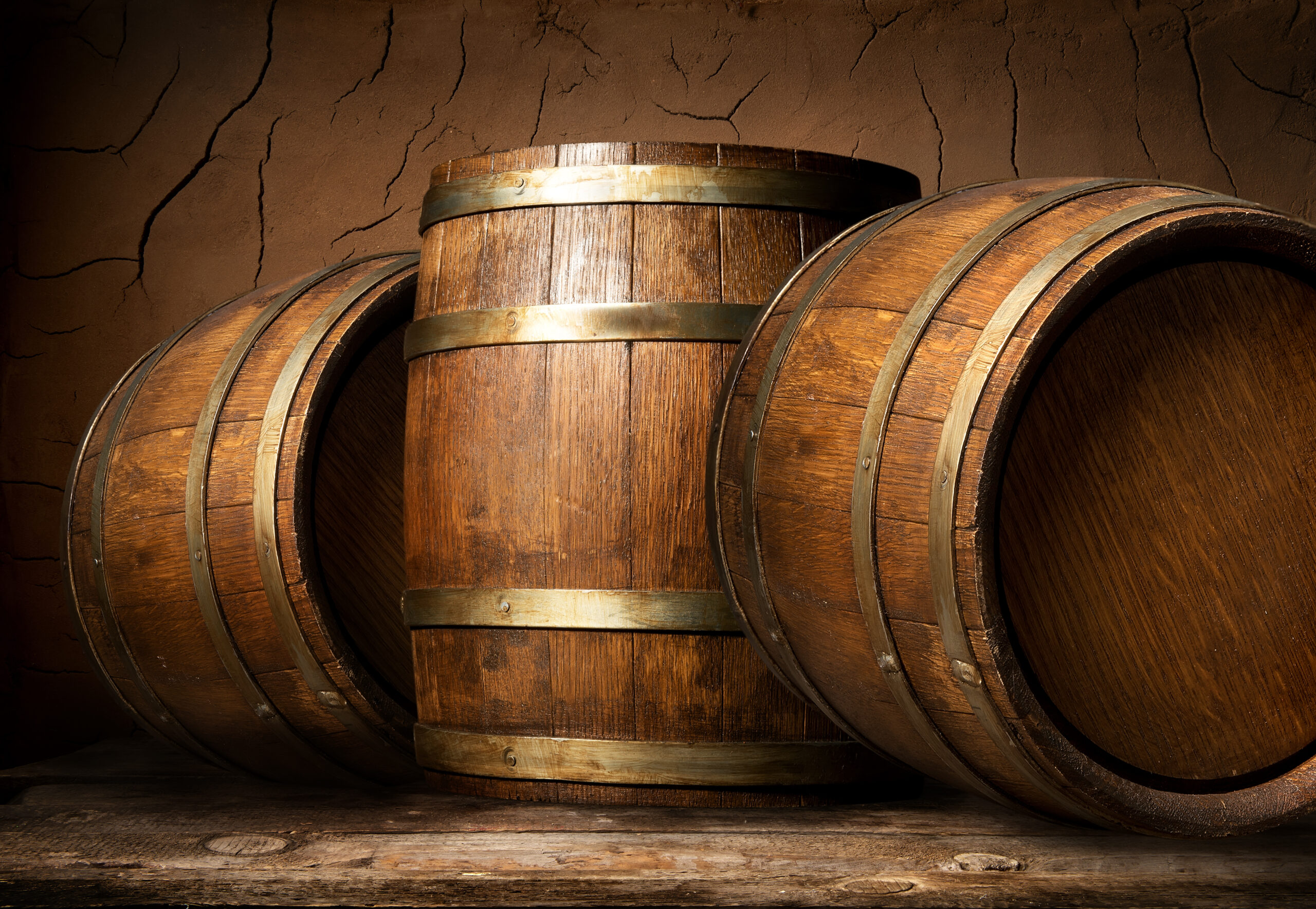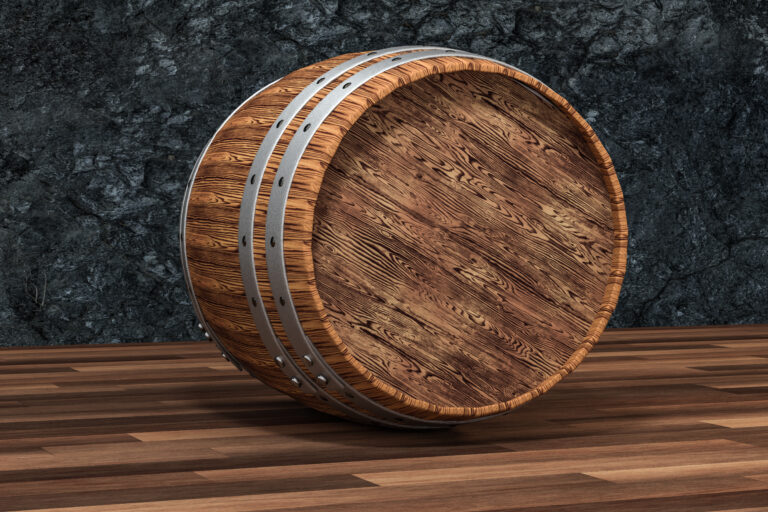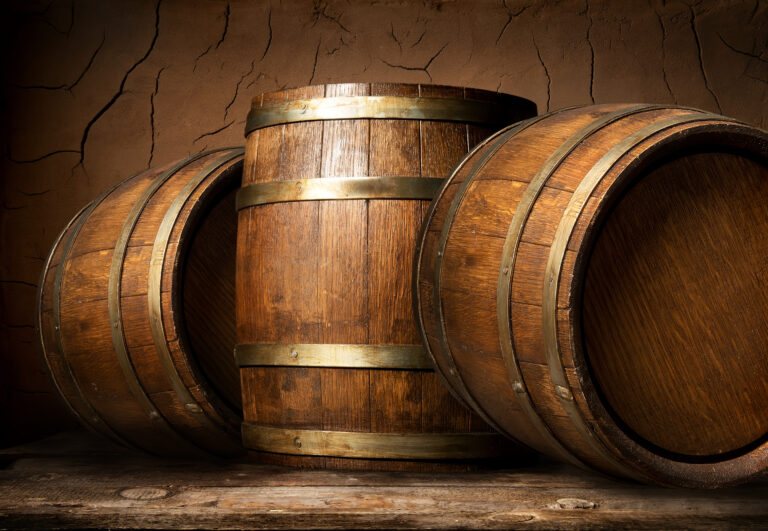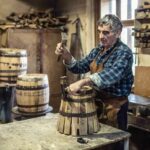Ever paused to truly wonder about the magic behind your favorite glass of whiskey? It all kicks off with something surprisingly simple: a single, unassuming oak barrel. This isn’t just any container; it’s a trusty vessel embarking on an epic adventure, spanning years and countless miles, ultimately transforming raw spirit into the smooth, delicious elixir we know and love.
Our story begins by carefully selecting the finest grains – typically barley, wheat, and rye. These aren’t just tossed in; they’re meticulously malted, mixed, and mashed to create a sweet, malty liquid known as wort. Then, the real party starts! Yeast is introduced to the wort, kicking off fermentation. The yeast happily devours the sugars, releasing alcohol and CO2 as byproducts. This bubbly, yeasty concoction is now affectionately called distiller’s beer.
Next up, the distiller’s beer gets a good boil and goes through multiple rounds of distillation to concentrate that precious alcohol. The resulting spirit, now crystal clear like water, is called new make or white dog. It’s brimming with potential and flavor, but it’s still pretty feisty and unaged. And this, my friends, is where our trusty whiskey barrel steps in. The new make is carefully poured into charred oak barrels, often repurposed bourbon barrels, ready for its long slumber.
Crafting the Perfect Vessel: Selecting the Wood for Whiskey Barrels
The journey of transformation truly begins with the careful selection of the wood for these vital whiskey barrels. Most commonly, white oak from the Quercus alba tree is chosen for its exceptional properties in aging spirits. This wood is a true marvel – porous enough to allow the spirit to breathe and interact with oxygen, yet incredibly sturdy to hold the liquid without a single leak.
Once the majestic oak trees are harvested, the wood undergoes a meticulous curing process before being expertly shaped into staves – those narrow, curved strips that form the backbone of the barrel. These staves are then gently heated and bent into their iconic barrel shape, held firmly together by sturdy metal hoops.
Charring the inside of the barrel is the next, absolutely crucial step. This isn’t just burning wood; it’s a carefully controlled process that creates a layer of activated charcoal on the inner surface. This char is a game-changer, interacting dynamically with the spirit, imparting those coveted smoky flavors and a beautiful hue to the aged whiskey. The level of char is a precise art, depending on the desired outcome; lighter chars yield subtler nuances, while heavier chars lead to more robust, complex smoky tones.
After their fiery baptism, these newly crafted oak barrels are rinsed to remove any lingering debris, then they’re primed and ready for their precious cargo. Distillers carefully fill them with the unaged spirit, the new make. As the whiskey peacefully rests, natural chemical reactions dance between the spirit, the oak wood, and that vital char. Compounds elegantly break down and recombine, giving birth to a symphony of new and complex whiskey flavors.
Even the barrel’s humble abode, the barrel warehouse, and its specific position within it, play a starring role in the final flavor profile. Warehouses in regions with dramatic temperature swings encourage more spirited interaction between the liquid and the wood due to constant expansion and contraction. Heat coaxes the spirit deeper into the wood’s embrace, while colder temperatures encourage it to retract, fostering a dynamic exchange.
After a minimum of 2-5 years of patient waiting, the master distiller makes the pivotal decision: Is the whiskey ready to be bottled as-is, or does it crave further aging? Many premium single malt and bourbon whiskeys gracefully age for 10-20 years or even longer, striving for the pinnacle of flavor and complexity. Once bottled, you get to finally savor the delicious culmination of this extraordinary journey!
The Artisan’s Touch: Building and Charring the Barrels
Once the whiskey has undergone its initial distillation, it’s eagerly transferred into those specially prepared charred oak barrels to embark on its flavor development journey. Barrel making is a time-honored art form, a craft refined over centuries.
Selecting the Oak Wood
The preferred oak wood for these barrels is typically American oak or European oak. This wood boasts tight grains that are remarkably leak-resistant, and crucially, it generously imparts highly desirable whiskey flavors like vanilla, caramel, and subtle spice notes. The staves, those essential planks, are meticulously cut and shaped to perfection.
Assembling the Barrels
The individual staves are skillfully assembled to form the iconic barrel shape, then firmly secured with robust metal hoops. The assembled barrel is then gently toasted over an open flame. This gentle heat warms the wood, allowing it to bend gracefully into shape and preparing it to receive the eagerly awaiting new make spirit.
The Art of Charring
The inside of the barrel then undergoes the transformative process of charring, which effectively opens up the wood’s pores. Charring the barrel creates a layer of activated charcoal. This activated charcoal acts as a natural filter, helping to mellow and refine the spirit. The specific level of char is a deliberate choice, carefully selected based on the desired whiskey profile. More char typically translates to greater color and flavor absorption, contributing to a richer, deeper spirit.
Filling the Barrels
Once meticulously built and perfectly toasted, the oak barrels are filled with the eager new make whiskey. Throughout the entire aging period, the whiskey slowly but surely soaks into the wood, diligently absorbing crucial compounds that bestow upon aged whiskey its characteristic color, enticing aroma, and complex taste. The whiskey is truly transformed into a finely tuned spirit, bursting with delightful vanilla, spice, and fruit notes, culminating in a long, warm finish.
And so, this is the profound journey of how a seemingly humble oak barrel evolves into the indispensable vessel for creating one of the world’s most prized spirits. From the initial grain to the final glass, every single step in crafting a memorable whiskey is absolutely essential.
The Great Sleep: Filling Barrels with New Make Whiskey
Once the intricate distillation process is complete, the vibrant new make whiskey is ready for its long and crucial period of aging and maturation in the charred oak barrels. This is where the whiskey’s color, its intricate flavor profile, and its captivating aroma truly begin to blossom and develop.
Choosing the Right Cask
The specific type of barrel used – from its size and the source of its oak wood to its level of char – will profoundly impact the flavor of the finished whiskey. For instance, Scotch whisky commonly utilizes once-used bourbon barrels for its aging, while bourbon itself demands brand new charred oak barrels. Before filling, every barrel is meticulously inspected to ensure it’s perfectly airtight.
The Fill and the Breath
The new make whiskey is then carefully transferred into the prepared barrels. As these barrels are filled, the natural expansion and contraction of the wood, driven by temperature changes, causes the whiskey to subtly seep into the wood, actively extracting a treasure trove of flavor compounds like vanilla, rich caramel, and intriguing spice notes. This incredible process is known as maturation, and for most whiskies, it typically spans at least 3 years.
Maturing in the Warehouse
The filled barrels are then carefully moved to a warehouse specifically designed for maturation. Here, factors like temperature, humidity, airflow, and other environmental elements all play a vital role in how the whiskey develops its unique character. Whiskey tends to mature faster in warmer temperatures, while cooler environments generally produce a mellower, smoother spirit. Master distillers are constantly on the pulse, frequently sampling from different barrels to precisely determine when each batch has reached its absolute peak in terms of maturity and flavor.
The Deciding Moment: When is it Ready?
There’s no rigid timetable for when a whiskey is deemed ready for bottling; it’s purely a judgment based on its flavor. Once the distiller, with their seasoned palate, determines that the whiskey in a particular barrel has reached its full potential, it’s either bottled as a single malt, expertly blended with other barrels, or perhaps even chosen for further aging. The incredible journey that began with humble malted barley now culminates in a complex, exquisitely flavorful spirit, ready to be enjoyed in your glass. Sláinte!
The Heart of the Transformation: Maturing Whiskey in the Barrelhouse
Once the distillation process is complete, the vibrant new make whiskey is lovingly poured into charred oak barrels to begin its essential journey of maturation and flavor development. This is truly where the magic, the real alchemy of whiskey making, unfolds.
Inside the Barrelhouse
The barrelhouse is more than just a storage facility; it’s a dedicated warehouse where these precious whiskey barrels patiently rest during their maturation. Temperature and humidity are meticulously controlled to maximize the crucial interaction between the whiskey and the oak wood. As the whiskey quietly sits, a fascinating symphony of chemical reactions takes place:
- Extractives from the wood, such as lignin, tannins, and cellulose, gradually break down, generously imparting both rich flavor and captivating color to the whiskey. Vanillin, for instance, contributes those delightful hints of vanilla and oak.
- Oxygen gracefully enters the barrel through the porous oak wood, gently mellowing the whiskey by reacting with compounds like aldehydes and ketones. This subtle oxidation helps to soften and reduce any harsh, sharp flavors.
- The whiskey itself breathes, expanding and contracting with natural temperature changes, causing it to rhythmically move in and out of the wood. This mesmerizing phenomenon is affectionately known as the “breathing effect.”
- Both water and alcohol slowly evaporate from the barrel, especially in warmer climates – this is the famous “angel’s share.” The reduction in volume naturally concentrates the remaining flavors and aromas, intensifying the spirit.
- New compounds like esters and acetals gracefully form, creating delightful fruity notes reminiscent of apple or citrus.
The longer a whiskey matures, the more intricate and profound its flavor becomes. After 3-5 years, the barrel is typically emptied, and the aged whiskey is either bottled as a single malt or expertly blended with other whiskies. Some exceptional barrels are allowed to mature for decades, destined to become highly sought-after vintage and special reserve whiskeys.
The journey from new make spirit to fully mature whiskey is a long but incredibly rewarding one. Patience and time transform a harsh, unaged distillate into a wonderfully smooth, exquisitely flavorful drink. One sip of a truly fine aged whiskey and you’ll immediately appreciate the immense care and craftsmanship that went into its making. The barrelhouse is where spirits truly mature into something sublime.
The Palate’s Progress: Evaluating Whiskey as It Ages
As whiskey gracefully ages within the oak barrel, its flavor and aroma compounds undergo a dramatic and fascinating transformation. Evaluating whiskey as it ages involves carefully monitoring how these precious compounds evolve over time.
The Shifting Hue: Color
When whiskey is first barreled, it begins with a clear, light amber hue. As it diligently ages, it progressively deepens to a rich, dark amber or a beautiful light brown. The charred oak barrels are the generous donors of this vibrant color to the spirit during aging. Naturally, the longer it ages, the darker and more profound its color becomes.
An Evolving Bouquet: Aroma
Newly barreled whiskey initially presents a strong alcohol aroma, often with clear hints of the specific grain it was made from, be it corn, rye, or barley. Over time, that initial alcoholic sharpness gracefully mellows, giving way to the sweet, spicy scents of vanilla, cinnamon, and clove that are beautifully imparted by the oak barrel. Additional fruity notes like apple, citrus, or dried fruit may also emerge, adding layers of complexity to the aroma.
A Symphony of Taste: Flavor
At first, the flavor of young whiskey is predominantly characterized by the grain, often accompanied by a harsh, alcoholic burn. Gradually, that intense grainy flavor recedes, finding perfect balance with the warm, inviting oak flavors of vanilla, nuts, and spice. The initial alcoholic heat mellows into a pleasant, warm glow. As it ages further, even more sophisticated flavors develop, such as dried fruit, chocolate, or tobacco. The oak flavors intensify, becoming wonderfully rich and deeply complex in older whiskeys.
The Lingering Impression: Finish
The finish refers to the delightful aftertaste that gently lingers after swallowing. In young whiskey, the finish tends to be rather short and dominated by the grain and alcohol. However, in aged whiskey, the finish is long, remarkably smooth, and distinctly marked by beautiful oak and fruity notes. Subtle, complex flavors may continue to emerge even minutes after drinking, a testament to its depth.
Carefully evaluating how these essential elements—color, aroma, flavor, and finish—gracefully evolve over time provides invaluable insight into how whiskies age and truly develop their unique character. While aging is indeed a slow, gradual process, the rewards of complex, multi-dimensional flavor are undoubtedly well worth the patience required. Comparing young and aged whiskies side by side vividly reveals just how transformative the aging process can truly be.
The Distiller’s Call: Deciding When Whiskey Is Ready for Bottling
When it comes to determining if your prized whiskey has reached its peak and is ready for bottling, patience is truly a virtue. Unlike wine, whiskey ceases to age once it’s in the bottle, so you absolutely want to ensure it has matured to your desired taste profile before making that final decision.
The Visual Clue: Checking the Color
As whiskey patiently ages in the oak barrel, it gradually darkens in color due to both oxidation and the absorption of compounds from the charred oak. A good practice is to compare your whiskey’s color to others of the same type and age to gauge if it has deepened to your liking. Remember, the color can vary depending on the specific type of oak and the level of char, so consulting with your cooperage for guidance can be incredibly helpful.
The Ultimate Test: Sampling the Flavor
There’s truly only one way to definitively know if your whiskey is ready—give it a taste! Carefully draw a small sample from the barrel to meticulously evaluate its flavor. Initially, the whiskey will likely be quite harsh and prominently grain-forward. Over time, it mellows beautifully, developing rich notes of vanilla, warming spices like cinnamon or nutmeg, delightful dried or candied fruit, chocolate, coffee, and so much more, depending on the barrel type used. Sample regularly, perhaps every few months, until the flavor reaches that perfect point you’re eager to bottle.
The Alcohol’s Influence: Checking the ABV
As whiskey ages and some of the alcohol naturally evaporates – the aforementioned “angel’s share” – the alcohol by volume (ABV) will gradually decrease. Most distillers choose to bottle their whiskey once it reaches a certain preferred ABV, which also significantly impacts the overall flavor profile. The specific aging location and environmental factors greatly influence this evaporation, so regular checks of your barrel’s ABV are essential.
Making the Final Judgment Call
Based on the evolving color, the complex flavor, and the ideal ABV, you, the distiller, must determine if your whiskey has reached that sublime point you’re truly happy with. If it still needs more time, continue sampling every few months until it achieves perfection. Once you make the decisive call to bottle, promptly drain the barrel and bottle within a few days to prevent any further oxidation from altering its meticulously developed flavor. Your incredible whiskey adventure now triumphantly continues in the bottle!
With patience and a truly experienced palate, you’ll inherently know when your magnificent whiskey creation is ready to be shared with the world. The remarkable journey from grain to glass is undeniably well worth the wait.
A New Chapter: Dump, Rinse, Refill: Reusing Barrels
Once a whiskey barrel has dutifully served its purpose, patiently aging whiskey for a number of years, it’s a common and sustainable practice for distilleries to reuse them. This process, known as “dumping and refilling,” not only helps maximize valuable resources but can also magically create even more complex and nuanced flavors in the subsequent batches of whiskey.
The Unveiling: Emptying the Barrel
The initial step is to gently empty the barrel of its precious, aged contents. This is typically done by manually opening the barrel’s bunghole and carefully draining the whiskey into a designated holding tank or container. Any lingering whiskey that has lovingly soaked into the oak wood is then rinsed out with pure water. At this point, the barrel is physically empty, but its oak wood remains wonderfully infused with the rich flavor compounds from its original aging journey.
Preparation for a New Life: Cleaning and Inspecting
Before refilling, the barrel undergoes a thorough inspection to ensure it’s still structurally sound and ready for another round. Any minor leaks or damage are meticulously repaired. The barrel is then given another rinse to remove any remaining debris. Some forward-thinking distilleries even give the barrels a quick, light charring to reinvigorate the wood, preparing it for its next occupant. The barrels are then primed and ready to be refilled.
A Fresh Start: Filling with New Make
The now empty, but still flavor-infused, barrel is filled with fresh, unaged whiskey, affectionately known as “new make” or “white dog.” The new make eagerly absorbs the embedded flavors in the oak wood like a thirsty sponge. Additionally, residual compounds from the wood itself and leftover whiskey residues from the previous batch contribute to a wonderfully complex array of new tastes. The aging process continues as normal, but often at an accelerated rate due to the barrel’s previous use.
The Magic of Second Life: Enhanced Flavor
Whiskey aged in used barrels often boasts wonderfully enhanced flavor notes from this unique double maturation. Reusing barrels is not only an economical approach for distilleries but also a brilliant way to craft more nuanced, deeply complex whiskies without the need to wait for brand new barrels to age for extensive periods. The practice of reusing barrels is certainly here to stay, as distilleries continue to seek innovative ways to meet the growing global demand for exceptional aged whiskey.
Reusing barrels helps distilleries maximize their resources while simultaneously creating whiskey with incredible layers of complex flavors. Though a cost-effective measure, the resulting spirits are anything but cheap in taste or quality. Distilleries are empowered to craft truly multi-dimensional whiskies that brilliantly stand out in an ever-expanding market. All thanks to the time-honored tradition of dumping, rinsing, and refilling.
The Barrel’s Deep Influence: Impact of the Barrel on Whiskey Flavor
The barrels used to age whiskey exert an absolutely enormous impact on the final flavor profile of the spirit. Whiskey barrels are far more than just containers; they are active agents of transformation, actively shaping the liquid within. As whiskey patiently spends years maturing in barrels, it continuously absorbs vital compounds from the oak wood that profoundly alter its aroma, taste, and even its visual color.
The Heart of the Matter: The Wood
The specific type of wood utilized for the barrels fundamentally affects the whiskey. For instance, bourbon must legally be aged in new charred oak barrels, almost always American white oak. This particular oak wood generously imparts those quintessential vanilla and caramel flavors to the bourbon. For Scotch whisky, while used bourbon barrels are commonly employed, sherry casks and other varieties of oak barrels are also highly popular. The previous contents of these used barrels and the specific oak variety profoundly influence the Scotch’s flavor.
The Fiery Imprint: The Char
Before being filled, whiskey barrels undergo a crucial process called charring – exposing the inside of the barrel to an open flame. The charring level, ranging from light to heavy, dictates precisely how much the whiskey will absorb compounds from the oak wood. A heavier char means a greater surface area within the wood for the whiskey to interact with, often resulting in a darker, smokier spirit. The char also plays a vital role in filtering and mellowing the whiskey, contributing to its overall smoothness.
The Breath of Life: The Air
Whiskey matures and develops its intricate flavor through the twin processes of oxidation and evaporation. As the barrel “breathes,” oxygen slowly enters and interacts with the whiskey. This gentle oxidation helps to mellow and round out the flavor. Alcohol and water also gradually evaporate from the barrel, especially in warmer climates like those of Kentucky and Tennessee – this is famously known as the “angel’s share.” The evaporation effectively concentrates the remaining whiskey in the barrel, significantly helping to develop its complexity and depth.
The Test of Time: The Time
The longer a whiskey spends aging in barrels, the more complex and refined its flavor becomes. Young whiskies tend to be bolder, spicier, and sometimes a bit rough around the edges. Extended aging allows more flavors from the oak wood and greater oxidation to emerge, smoothing out the spirit into a beautifully balanced, sophisticated drink. Many premium whiskies are patiently aged for 12 years or even more to achieve an exceptionally complex and nuanced flavor profile.
The incredible journey within the whiskey barrel, from humble grain to glass, is truly at the heart of what makes whiskey such a distinctive, wonderfully flavorful spirit. All the intricate factors at play during maturation culminate to create a whiskey’s unique taste and unforgettable character.
The Journey of a Whiskey Barrel: From Grain to Glass FAQ
Making whiskey is undeniably an art form that demands immense patience and meticulous care. The journey truly begins with malted barley, a crucial grain that provides the essential starch needed to produce alcohol. The barley is then carefully mixed with water, gently heated, and specific enzymes are added to convert that starch into fermentable sugar. Next, yeast is introduced to ferment the sugar into alcohol. This produces a liquid known as distillers beer or wash, which typically has an alcohol percentage of about 5-10%.
The wash is then expertly distilled in gleaming copper pot stills or efficient column stills. The copper plays a vital role, helping to remove undesirable sulfur compounds and contributing to a smooth, clean distillate. The distillate is carefully collected and then distilled again, further increasing the alcohol content to a robust 60-70% ABV. This double-distilled spirit is what we proudly call new make whiskey.
Maturing the Spirit
The vibrant new make whiskey is then meticulously filled into charred oak casks, most commonly former bourbon barrels. These precious whiskey barrels are then thoughtfully warehoused for their long period of aging. Over the course of years, the new make spirit gradually absorbs rich flavor and beautiful color from the oak wood. As it patiently ages, up to 2% of the spirit gracefully evaporates each year through the barrel’s pores – this is famously known as the “angel’s share.”
Blending and Bottling
After patiently aging for at least 3 years (and often much, much longer for premium expressions), the whiskey barrels are finally emptied, and their contents are expertly blended together to create the desired final flavor profile. The skillfully blended whiskey is then typically diluted to its chosen bottling strength, usually around 40% ABV, and finally, bottled.
It’s a long, incredibly complex journey, but one that ultimately produces an exceptional spirit. The masterful marriage of premium ingredients, the efficiency of copper pot stills, the transformative power of oak casks, and years of dedicated patience yields a smooth, mellow whiskey with incredible depth of flavor that is truly meant to be savored. Sláinte!
Final Thoughts on the Whiskey Barrel Journey
You’ve now taken a captivating deep dive into the incredible journey that makes that exquisite glass of whiskey in your hand possible. From the rolling, mist-kissed hills of Scotland to the sun-drenched rickhouses of Kentucky, an immense amount of care, dedication, and true craftsmanship goes into producing one of the world’s most prized spirits.
The next time you gently swirl, inhale the complex aromas, and finally sip an aged whiskey, whether you enjoy it neat or on the rocks, take a moment to truly appreciate the years of unwavering dedication behind it. Raise your glass high and toast the unsung heroes: the farmers who cultivate the grains, the skilled coopers who craft the transformative barrels, the innovative distillers who coax life from the new make, and the masterful blenders who orchestrate the final symphony of flavors. Their profound skills and passion, lovingly passed down through generations, are truly worth savoring as much as the whiskey itself. Here’s to the remarkable journey of the whiskey barrel and the sweet, complex rewards that await at its magnificent end. Cheers!







